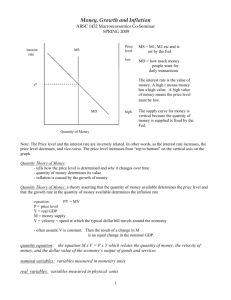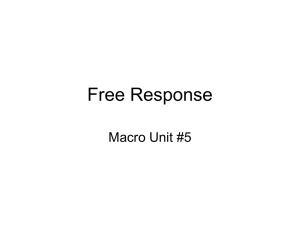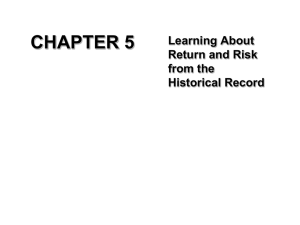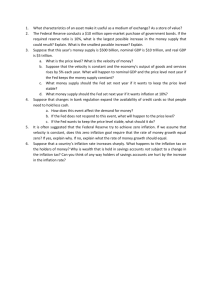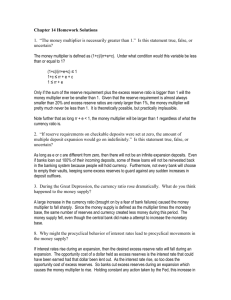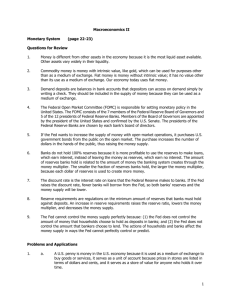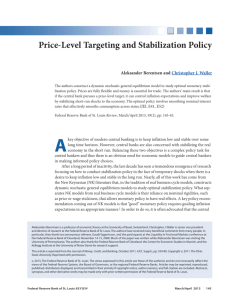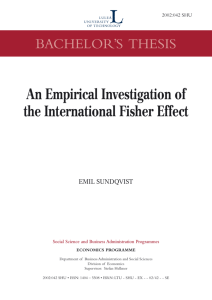HWPS#3
advertisement
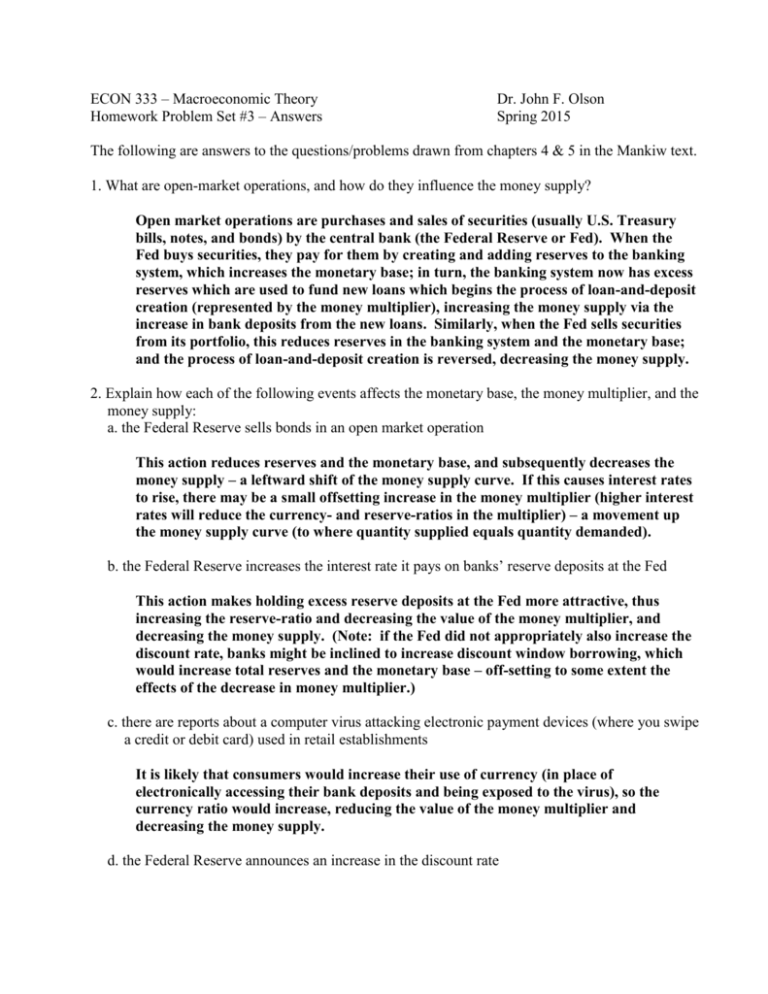
ECON 333 – Macroeconomic Theory Homework Problem Set #3 – Answers Dr. John F. Olson Spring 2015 The following are answers to the questions/problems drawn from chapters 4 & 5 in the Mankiw text. 1. What are open-market operations, and how do they influence the money supply? Open market operations are purchases and sales of securities (usually U.S. Treasury bills, notes, and bonds) by the central bank (the Federal Reserve or Fed). When the Fed buys securities, they pay for them by creating and adding reserves to the banking system, which increases the monetary base; in turn, the banking system now has excess reserves which are used to fund new loans which begins the process of loan-and-deposit creation (represented by the money multiplier), increasing the money supply via the increase in bank deposits from the new loans. Similarly, when the Fed sells securities from its portfolio, this reduces reserves in the banking system and the monetary base; and the process of loan-and-deposit creation is reversed, decreasing the money supply. 2. Explain how each of the following events affects the monetary base, the money multiplier, and the money supply: a. the Federal Reserve sells bonds in an open market operation This action reduces reserves and the monetary base, and subsequently decreases the money supply – a leftward shift of the money supply curve. If this causes interest rates to rise, there may be a small offsetting increase in the money multiplier (higher interest rates will reduce the currency- and reserve-ratios in the multiplier) – a movement up the money supply curve (to where quantity supplied equals quantity demanded). b. the Federal Reserve increases the interest rate it pays on banks’ reserve deposits at the Fed This action makes holding excess reserve deposits at the Fed more attractive, thus increasing the reserve-ratio and decreasing the value of the money multiplier, and decreasing the money supply. (Note: if the Fed did not appropriately also increase the discount rate, banks might be inclined to increase discount window borrowing, which would increase total reserves and the monetary base – off-setting to some extent the effects of the decrease in money multiplier.) c. there are reports about a computer virus attacking electronic payment devices (where you swipe a credit or debit card) used in retail establishments It is likely that consumers would increase their use of currency (in place of electronically accessing their bank deposits and being exposed to the virus), so the currency ratio would increase, reducing the value of the money multiplier and decreasing the money supply. d. the Federal Reserve announces an increase in the discount rate The increase in the discount rate should have two effects – 1) banks would decrease their borrowings of reserves at the discount window, which would decrease the monetary base and 2) banks would be likely to increase their holdings of excess reserves (it is more costly now to borrow to cover deficient reserve positions), which would increase the reserve ratio and lower the money multiplier. So, the combined effects of a lower monetary base and lower money multiplier will decrease the money supply. 3. What is the Fisher equation? What is the Fisher effect? Why is the real interest rate the relevant/appropriate “price” for the macroeconomic credit (flow-of-funds) market to equilibrate saving and investment, yet the nominal interest rate is the appropriate opportunity cost of holding money? The Fisher equation expresses that the nominal interest rate is equal to the sum of the real interest and the expected rate of inflation: i = R + π. The Fisher effect is that an increase in the expected inflation rate causes a one-for-one (identical, same-sized) increase in the nominal interest rate. Credit (flow-of-funds) market decisions, such as those for investment and consumptionsaving, are “real” decisions; that is, economic agents are making choices based on the relative opportunity costs of using funds in the present vs. the future – what matters in making those choices is the real benefits vs. the real costs of using those funds. Thus, the real interest rate is the relevant/appropriate price (changes in the nominal price level do not affect the real value of those funds). However, because money has a fixed nominal value ($1 today is still $1 in the future), holding money (as opposed to a nonmoney asset) has two opportunity costs. The first is real value foregone (as measured by the real interest rate) in not holding some non-money asset; the second is the loss of value as inflation reduces the real purchasing power of a unit of money. Thus, the nominal interest rate, expressed by Fisher’s equation (i = R + π), is the appropriate opportunity cost of holding money. 4. Suppose that for a country’s economy, the velocity of money is constant. Real GDP is growing by 5 percent per year, the money stock is growing at 14 percent per year, and the nominal interest rate is 11 percent. What is the real interest rate? (Provide/show your reasoning.) Using the equation of exchange expressed in percentage change terms/form (%M + %V = %P + %y), we have 14% + 0% = %P + 5%, which yields %P = 9%. Then using Fisher’s equation (i=R+%P or i-%P = R), 11%-9% = R = 2%. 5. List five costs of expected inflation. What is a cost of unexpected inflation? What is a possible benefit of the Federal Reserve having a target inflation rate of 2 percent? The five costs of expected inflation are: 1) shoeleather costs, 2) menu costs, 3) the cost of relative price variability (some nominal prices change more quickly than others), 4) tax distortions, and 5) the inconvenience of making inflation corrections (in determining relative price levels). A cost of unexpected inflation is that it causes arbitrary redistributions of wealth between debtors and creditors. One possible benefit of inflation is that it may improve the operation of labor markets by allowing real wages to reach equilibrium levels without reducing nominal wages (that is, having some small amount of inflation provides a “cushion” to avoid cutting nominal wages when real wages need to fall – employers give workers no raises or nominal raises which are less than the inflation rate). 6. What is meant by the “neutrality of money”? How does this concept/proposition relate to the “classical dichotomy”? The “neutrality of money” refers to the proposition that changes in the stock of money in an economy have no effects on real economic activity – real output, employment, real expenditures, the real interest rate, and other real economic measures are unaffected by the quantity of money; that the quantity or stock of money only determines the price level and nominal values. This proposition yields or leads to the “classical dichotomy” – the separation of real and nominal variables in the economy. The values of “real” economic activity are determined by the underlying factors of production and choices or preferences of economic agents; “nominal” values are determined by the quantity of money in the economy.




